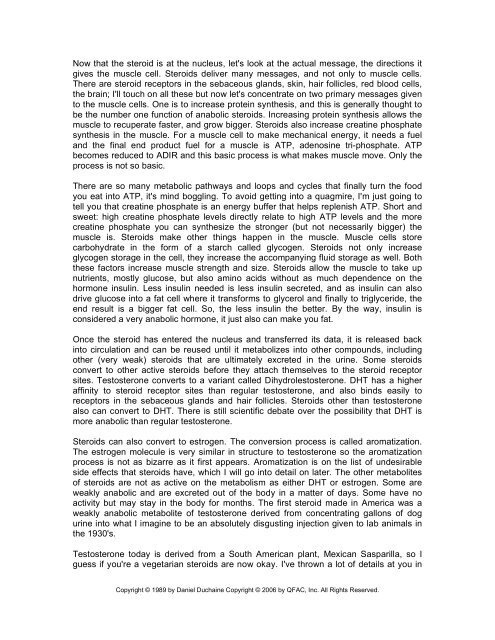Underground Steroid Handbook 2
Create successful ePaper yourself
Turn your PDF publications into a flip-book with our unique Google optimized e-Paper software.
Now that the steroid is at the nucleus, let's look at the actual message, the directions it<br />
gives the muscle cell. <strong>Steroid</strong>s deliver many messages, and not only to muscle cells.<br />
There are steroid receptors in the sebaceous glands, skin, hair follicles, red blood cells,<br />
the brain; I'll touch on all these but now let's concentrate on two primary messages given<br />
to the muscle cells. One is to increase protein synthesis, and this is generally thought to<br />
be the number one function of anabolic steroids. Increasing protein synthesis allows the<br />
muscle to recuperate faster, and grow bigger. <strong>Steroid</strong>s also increase creatine phosphate<br />
synthesis in the muscle. For a muscle cell to make mechanical energy, it needs a fuel<br />
and the final end product fuel for a muscle is ATP, adenosine tri-phosphate. ATP<br />
becomes reduced to ADIR and this basic process is what makes muscle move. Only the<br />
process is not so basic.<br />
There are so many metabolic pathways and loops and cycles that finally turn the food<br />
you eat into ATP, it's mind boggling. To avoid getting into a quagmire, I'm just going to<br />
tell you that creatine phosphate is an energy buffer that helps replenish ATP. Short and<br />
sweet: high creatine phosphate levels directly relate to high ATP levels and the more<br />
creatine phosphate you can synthesize the stronger (but not necessarily bigger) the<br />
muscle is. <strong>Steroid</strong>s make other things happen in the muscle. Muscle cells store<br />
carbohydrate in the form of a starch called glycogen. <strong>Steroid</strong>s not only increase<br />
glycogen storage in the cell, they increase the accompanying fluid storage as well. Both<br />
these factors increase muscle strength and size. <strong>Steroid</strong>s allow the muscle to take up<br />
nutrients, mostly glucose, but also amino acids without as much dependence on the<br />
hormone insulin. Less insulin needed is less insulin secreted, and as insulin can also<br />
drive glucose into a fat cell where it transforms to glycerol and finally to triglyceride, the<br />
end result is a bigger fat cell. So, the less insulin the better. By the way, insulin is<br />
considered a very anabolic hormone, it just also can make you fat.<br />
Once the steroid has entered the nucleus and transferred its data, it is released back<br />
into circulation and can be reused until it metabolizes into other compounds, including<br />
other (very weak) steroids that are ultimately excreted in the urine. Some steroids<br />
convert to other active steroids before they attach themselves to the steroid receptor<br />
sites. Testosterone converts to a variant called Dihydrolestosterone. DHT has a higher<br />
affinity to steroid receptor sites than regular testosterone, and also binds easily to<br />
receptors in the sebaceous glands and hair follicles. <strong>Steroid</strong>s other than testosterone<br />
also can convert to DHT. There is still scientific debate over the possibility that DHT is<br />
more anabolic than regular testosterone.<br />
<strong>Steroid</strong>s can also convert to estrogen. The conversion process is called aromatization.<br />
The estrogen molecule is very similar in structure to testosterone so the aromatization<br />
process is not as bizarre as it first appears. Aromatization is on the list of undesirable<br />
side effects that steroids have, which I will go into detail on later. The other metabolites<br />
of steroids are not as active on the metabolism as either DHT or estrogen. Some are<br />
weakly anabolic and are excreted out of the body in a matter of days. Some have no<br />
activity but may stay in the body for months. The first steroid made in America was a<br />
weakly anabolic metabolite of testosterone derived from concentrating gallons of dog<br />
urine into what I imagine to be an absolutely disgusting injection given to lab animals in<br />
the 1930's.<br />
Testosterone today is derived from a South American plant, Mexican Sasparilla, so I<br />
guess if you're a vegetarian steroids are now okay. I've thrown a lot of details at you in<br />
Copyright © 1989 by Daniel Duchaine Copyright © 2006 by QFAC, Inc. All Rights Reserved.


